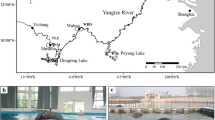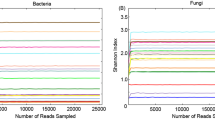Abstract
The aim of this study was to determine the bacteria present in the fecal material of the endangered Yangtze finless porpoise, Neophocaena phocaenoides asiaeorientalis. Fecal samples were collected from 12 Yangtze finless porpoises living in the wild at Poyang Lake, located in Jiangxi Province, China. To determine the bacterial diversity, a 16S rRNA gene clone library using the bacterial PCR primers fD1 and rP2, was prepared. A total of 138 near-full-length sequences were analyzed and 39 operational taxonomic units (OTUs) were identified. Sequences showing ≥97% similarity were grouped together as an OTU. Six different phyla were identified in which 38 OTUs were classified. Most of the OTUs contained sequences belonged to the phylum Firmicutes (51.3%), followed by Tenericutes (17.9%), Proteobacteria (15.4%), Actinobacteria (7.7%), Deinococcus-Thermus (2.6%) and Cyanobacteria (2.6%). A phylum could not be assigned for one clone within one OTU (2.6%). It appears that the Yangtze finless porpoise has a more diverse range of bacteria compared to other aquatic mammals, such as seals.


Similar content being viewed by others
References
Reeves RR, Wang JY, Leatherwood S (1997) The finless porpoise, Neophocaena phocaenoides (G. Cuvier, 1829): a summary of current knowledge and recommendations for conservation action. Asian Mar Biol 14:111–143
Gao A, Zhou K (1995) Geographical variation of external measurements and three subspecies of Neophocaena phocaenoides in Chinese waters. Acta Theriol Sinica 15:81–92
Wang D (2009) Population status, threats and conservation of the Yangtze finless porpoise. Chin Sci Bull 54:3473–3484
Wang K, Wang D, Zhang X, Pfluger A, Barrett L (2006) Range-wide Yangtze freshwater dolphin expedition: the last chance to see Baiji? Environ Sci Pollut Res 13:418–424
Hilton-Taylor C (2000) 2000 IUCN red list of threatened species. IUCN-The World Conservation Union, Gland
Dethlefsen L, Eckburg PB, Bik EM, Relman DA (2006) Assembly of the human intestinal microbiota. Trends Ecol Evol 21:517–523
Savage DC (1977) Microbial ecology of the gastrointestinal tract. Annu Rev Microbiol 31:107–133
Mazmanian SK, Liu CH, Tzianabos AO, Kasper DL (2005) An immunomodulatory molecule of symbiotic bacteria directs maturation of the host immune system. Cell 122:107–118
Klein S, Cohn MD, Alpers DH (1998) Alimentary tract in nutrition. In: Shils ME, Olson JA, Shike M, Ross AC (eds) Modern nutrition in health and disease. Williams and Wilkins, Baltimore, p 1140
Nossa CW, Oberdorf WE, Yang L, Aas JA, Paster BJ, Desantis TZ, Brodie EL, Malamud D, Poles MA, Pei Z (2010) Design of 16S rRNA gene primers for 454 pyrosequencing of the human foregut microbiome. World J Gastroenterol 16:4135–4144
Amann RI, Ludwig W, Schleifer KH (1995) Phylogenetic identification and in situ detection of individual microbial cells without cultivation. Microbiol Rev 59:143–169
Vaughan EE, Schut F, Heilig GHJ, Zoetendal EG, de Vos WM, Akkermans ADL (2000) A molecular view of the intestinal ecosystem. Curr Issues Intest Microbiol 1:1–12
Zoetendal EG, Collier CT, Koike S, Mackie RI, Gaskins HR (2004) Molecular ecological analysis of the gastrointestinal microbiota: a review. J Nutr 134:465–472
Eckburg PB, Bik EM, Bernstein CN, Purdom E, Dethlefsen L, Sargent M, Gill SR, Nelson KE, Relman DA (2005) Diversity of the human intestinal microbial flora. Science 308:1635–1638
Chang JY, Antonopoulos DA, Kalra A, Tonelli A, Khalife WT, Schmidt TM (2008) Decreased diversity of the fecal microbiome in recurrent Clostridium difficile-associated diarrhea. J Infect Dis 197:435–438
Turnbaugh PJ, Hamady M, Yatsunenko T, Cantarel BL, Duncan A, Ley RE, Sogin ML, Jones WJ, Roe BA, Affourtit JP, Egholm M, Henrissat B, Heath AC, Knight R, Gordon JI (2009) A core gut microbiome in obese and lean twins. Nature 457:480–484
Glad T, Bernhardsen P, Nielsen KM, Brusetti L, Andersen M, Aars J, Sundset MA (2010) Bacterial diversity in faeces from polar bear (Ursus maritimus) in Arctic Svalbard. BMC Microbiol 10:10
Zhang H, Chen L (2010) Phylogenetic analysis of 16S rRNA gene sequences reveals distal gut bacterial diversity in wild wolves (Canis lupus). Mol Biol Rep 37:4013–4022
Frey JC, Rothman JM, Pell AN, Nizeyi JB, Cranfield MR, Angert ER (2006) Fecal bacterial diversity in a wild gorilla. Appl Environ Microbiol 72:3788–3792
Brooks SP, McAllister M, Sandoz M, Kalmokoff ML (2003) Culture-independent phylogenetic analysis of the faecal flora of the rat. Can J Microbiol 49:589–601
Durso LM, Harhay GP, Smith TP, Bono JL, Desantis TZ, Harhay DM, Andersen GL, Keen JE, Laegreid WW, Clawson ML (2010) Animal-to-animal variation in fecal microbial diversity among beef cattle. Appl Environ Microbiol 76:4858–4862
Yang LY, Chen J, Cheng XL, Xi DM, Yang SL, Deng WD, Mao HM (2010) Phylogenetic analysis of 16S rRNA gene sequences reveals rumen bacterial diversity in Yaks (Bos grunniens). Mol Biol Rep 37:553–562
Deng WD, Wanapat M, Ma SC, Chen J, Xi DM, He TB, Yang ZF, Mao HM (2007) Phylogenetic analysis of 16S rDNA sequences manifest rumen bacterial diversity in Gayals (Bos frontalis) fed fresh bamboo leaves and twigs (Sinarumdinaria). Asian-Aust J Anim Sci 20:1057–1066
Yang SL, Ma SC, Chen J, Mao HM, Deng WD, Xi DM, Yang LY, Yang ZF, He TB (2010) Bacterial diversity in the rumen of Gayal (Bos frontalis), Swamp buffalo (Bubalus bubalis) and Holstein Cow (Bos taurus) as revealed by cloned 16S rRNA gene sequences. Mol Biol Rep 37:2063–2073
Glad T, Kristiansen VF, Nielsen KM, Brusetti L, Wright AD, Sundset MA (2010) Ecological characterization of the colonic microbiota in arctic and sub-arctic seals. Microb Ecol 60:320–330
McLaughlin RW, Zheng JS, Chen MM, Zhao QZ, Wang D (2011) Detection of Helicobacter in the fecal material of the endangered Yangtze finless porpoise, Neophocaena phocaenoides asiaeorientalis. Dis Aquat Org 95:241–245
Suchodolski JS, Ruaux CG, Steiner JM, Fetz K, Williams DA (2005) Assessment of the qualitative variation in bacterial microflora among compartments of the intestinal tract of dogs by use of a molecular fingerprinting technique. Am J Vet Res 66:1556–1562
Ritchie LE, Steiner JM, Suchodolski JS (2008) Assessment of microbial diversity along the feline intestinal tract using 16S rRNA gene analysis. FEMS Microbiol Ecol 66:590–598
Weisburg WG, Barns SM, Pelletier DA, Lane DJ (1991) 16S ribosomal DNA amplification for phylogenetic study. J Bacteriol 173:697–703
Schloss PD, Westcott SL, Ryabin T, Hall JR, Hartmann M, Hollister EB, Lesniewski RA, Oakley BB, Parks DH, Robinson CJ, Sahl JW, Stres B, Thallinger GG, Van Horn DJ, Weber CF (2009) Introducing mothur: open-source, platform-independent, community-supported software for describing and comparing microbial communities. Appl Environ Microbiol 75:7537–7541
Tamura K, Dudley J, Nei M, Kumar S (2007) MEGA4: Molecular evolutionary genetics analysis (MEGA) software version 4.0. Mol Biol Evol 24:1596–1599
Ley RE, Hamady M, Lozupone C, Turnbaugh PJ, Ramey RR, Bircher JS, Schlegel ML, Tucker TA, Schrenzel MD, Knight R, Gordon JI (2008) Evolution of mammals and their gut microbes. Science 320:1647–1651
An D, Dong X, Dong Z (2005) Prokaryote diversity in the rumen of yak (Bos grunniens) and Jinnan cattle (Bos taurus) estimated by 16S rDNA homology analyses. Anaerobe 11:207–215
Daly K, Stewart CS, Flint HJ, Shirazi-Beechey SP (2001) Bacterial diversity within the equine large intestine as revealed by molecular analysis of cloned 16S rRNA genes. FEMS Microbiol Ecol 38:141–151
Sundset MA, Cann IKO, Mathiesen SD, Mackie RI (2004) Rumen microbial ecology in reindeer-adaptations to a unique diet. J Anim Feed Sci 13(Suppl. 1):717–720
Hirsh DC, Biberstein EL (2005) Clostridium. In: Hirsh DC, MacLachlan NJ, Walker RL (eds) Veterinary microbiology. Blackwell Publishing, Ames, pp 198–214
Cano RJ, Tiefenbrunner F, Ubaldi M, Del Cueto C, Luciani S, Cox T, Orkand P, Künzel KH, Rollo F (2000) Sequence analysis of bacterial DNA in the colon and stomach of the Tyrolean Iceman. Am J Phys Anthropol 112:297–309
Leser TD, Amenuvor JZ, Jensen TK, Lindecrona RH, Boye M, Møller K (2002) Culture-independent analysis of gut bacteria: the pig gastrointestinal tract microbiota revisited. Appl Environ Microbiol 68:673–690
Szekely BA, Singh J, Marsh TL, Hagedorn C, Werre SR, Kaur T (2010) Fecal bacterial diversity of human-habituated wild chimpanzees (Pan troglodytes schweinfurthii) at mahale mountains national park, Western Tanzania. Am J Primatol 72:566–574
Higgins R (2000) Bacteria and fungi of marine mammals: a review. Can Vet J 41:105–116
Ozutsumi Y, Hayashi H, Sakamoto M, Itabashi H, Benno Y (2005) Culture-independent analysis of fecal microbiota in cattle. Biosci Biotechnol Biochem 69:1793–1797
Krogius-Kurikka L, Kassinen A, Paulin L, Corander J, Mäkivuokko H, Tuimala J, Palva A (2009) Sequence analysis of percent G+C fraction libraries of human faecal bacterial DNA reveals a high number of Actinobacteria. BMC Microbiol 9:68
Milne BW, Arnold MH, Hudson B, Coolican MR (2009) Infectious arthritis of the knee caused by Mycobacterium terrae: a case report. J Orthop Surg (Hong Kong) 17:103–108
Acknowledgments
We thank Dr. Bonnie Bratina, from the University of Wisconsin-La Crosse, for reviewing the manuscript and for her very helpful insights. We also thank Dr. Hao Y.J., Miss Guo A.H., and Mr. Wang J.Z for help in fecal sample collection. The experimental work was conducted in the molecular laboratory of Research Group on Conservation Biology of Aquatic Animals at the Institute of Hydrobiology, the Chinese Academy of Sciences. This project was supported by grants from the National Natural Science Foundation of China (No. 30730018, 31000168), and the National Basic Research Program of China (No. 2007CB411600).
Author information
Authors and Affiliations
Corresponding author
Electronic supplementary material
Below is the link to the electronic supplementary material.
Rights and permissions
About this article
Cite this article
McLaughlin, R.W., Chen, M., Zheng, J. et al. Analysis of the bacterial diversity in the fecal material of the endangered Yangtze finless porpoise, Neophocaena phocaenoides asiaeorientalis . Mol Biol Rep 39, 5669–5676 (2012). https://doi.org/10.1007/s11033-011-1375-0
Received:
Accepted:
Published:
Issue Date:
DOI: https://doi.org/10.1007/s11033-011-1375-0




